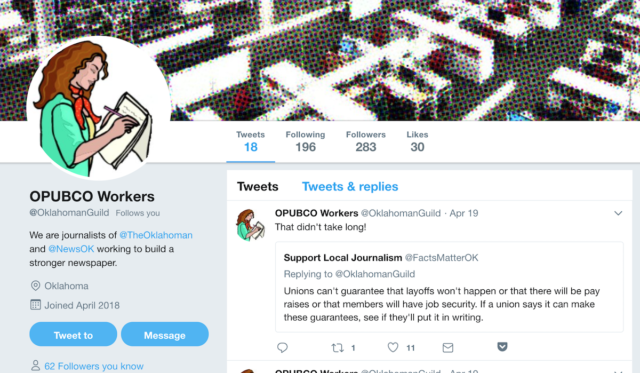
The week after Oklahoma’s largest labor demonstration in decades, supposed talk of unionization at the state’s largest newspaper kept workers’ rights — and the broader labor-relations discussion — alive in the Sooner State for a few more days.
An anonymous Twitter account (@OklahomanGuild) launched Thursday, April 19 — an awkward date, to be sure — with a cryptic tweet:
We are journalists at @NewsOK and @TheOklahoman who believe strong, thriving communities need strong, thriving newspapers.
— OPUBCO Workers (@OklahomanGuild) April 19, 2018
In Oklahoma journalism circles, the Oklahoman Guild tweet caused substantial murmuring followed, fittingly, by questions: Who is behind the account? How will leadership at The Oklahoman react? How would such an organization form? What benefits would journalists at the paper even receive by creating a union?
Four days later, most of those questions remain unanswered. The Twitter account has chirped only 18 times, revealing little in the way of goals, strategy or strength of effort. That’s not to say those things are absent, but for a potential movement launched in a public way, supporters of The Oklahoman’s oft-beleaguered journalists are left wondering whether a conversation that could be worth having will truly begin.
(A private message seeking comment sent Sunday to the @OklahomanGuild Twitter account was not returned prior to the publication of this editorial.)
Would Oklahoman Guild be like LAT Guild?
Travel three months back to January and two time zones west, and the journalists of the Los Angeles Times stand as a strong example for any newsroom seeking to form a union in the digital age.
The Los Angeles Times Guild formed via vote Jan. 19, with 248 staff members voting in favor of unionizing and 44 people voting against. The mission of the organization — which is part of the larger Communications Workers of America-affiliated NewsGuild enterprise — seems straightforward: “Our mission is to safeguard the future of the Los Angeles Times and its journalists.”
The LAT Guild describes its mission further:
A union is the best way for us to protect ourselves and ensure that we have a say in the critical decisions that shape our journalism.
We deserve to be compensated fairly for our hard work, our skills and our depth of experience. We are determined to halt the rampant turnover and knowledge flight that has destabilized our newsroom. With a union, we can begin to address stagnant wages, pay disparities and declining benefits. And we can create a workplace that reflects the diversity of Southern California.
Our No. 1 goal is the long-term success of The Times and its journalism. We believe the company shares that goal. The best way for the Los Angeles Times to flourish is through collective bargaining for its journalists.
We are asking Tronc, The Times’ parent company, to recognize the NewsGuild as our representative, and we are eager to work with management to achieve our shared goals.
The Times had been owned by Tronc since 2000, but less than three weeks after the LAT Guild’s creation, the paper published a report saying that billionaire Patrick Soon-Shiong had reached a deal to buy the LA Times. Soon-Shiong apparently plans to move the newsroom, but that’s not the only change that could be coming to the paper.
The LAT Guild is reportedly moving forward with plans for a class-action lawsuit regarding pay discrepancies at the Los Angeles Times. From Huffington Post:
Last week, the union released a comprehensive analysis of the newsroom’s pay structure, based upon data provided by the paper’s parent company, Tronc, as a part of the collective bargaining process. The union determined that “Tronc has underpaid women and journalists of color by thousands of dollars a year at the Los Angeles Times, suggesting systemic salary gaps by race and gender.”
In the shadows of Janus v. AFSCME
Whether journalists at The Oklahoman believe a “comprehensive analysis” of pay and other issues at the paper would yield fruitful information is yet to be seen. Virtually any organization circa 2018 should be considering issues of fairness and representation, but the existence of an anonymous “Oklahoman Guild” Twitter account should not be construed as evidence of systemic problems with The Oklahoman’s business management. Exactly what issues an Oklahoman Guild would focus on remains unclear.
More interesting to watch may well be the U.S. Supreme Court’s ruling in Janus v. AFSCME, a case questioning the legality of mandatory “agency fees” within unions that the Washington Post has dubbed “the biggest labor case of the century.”
Oklahomans interested in that case and other important stories will likely find the most thorough coverage of such issues from the dedicated journalists working at The Oklahoman.





















